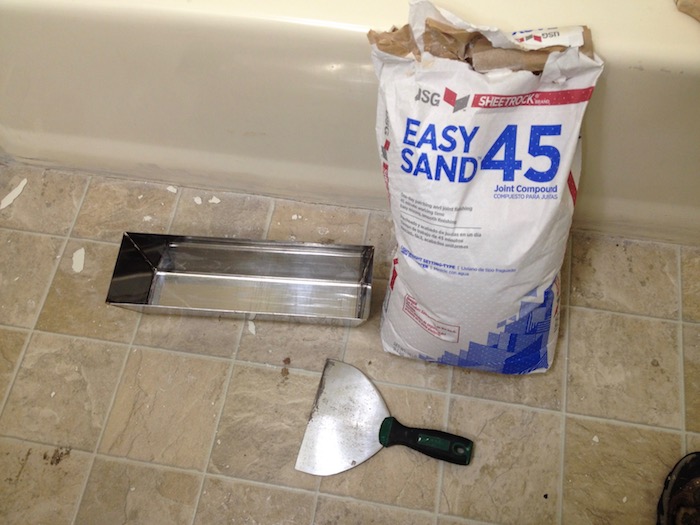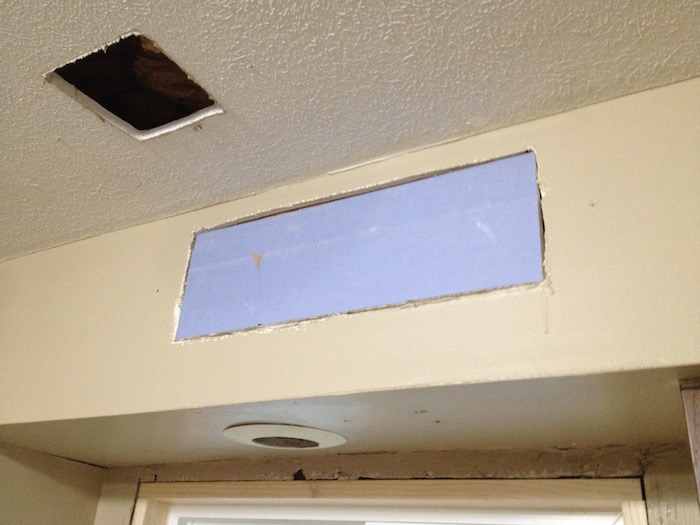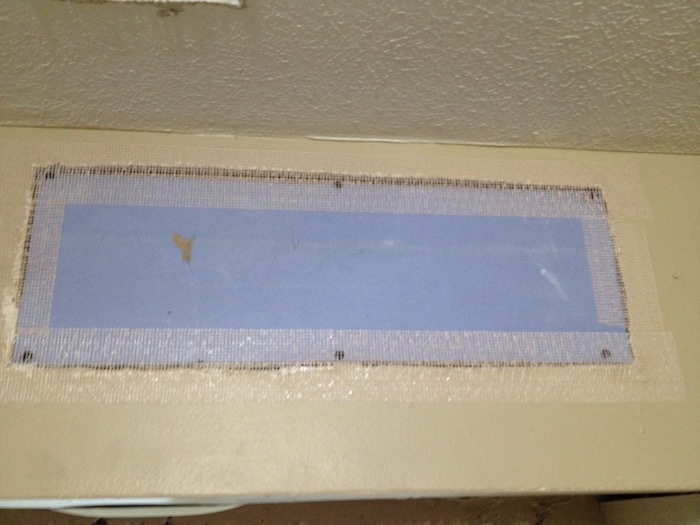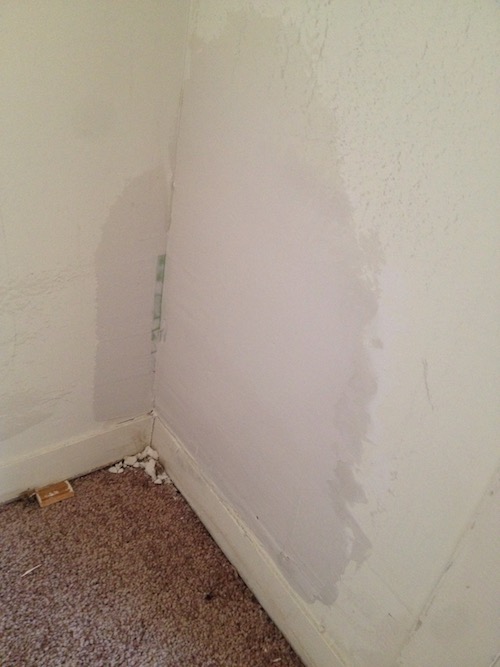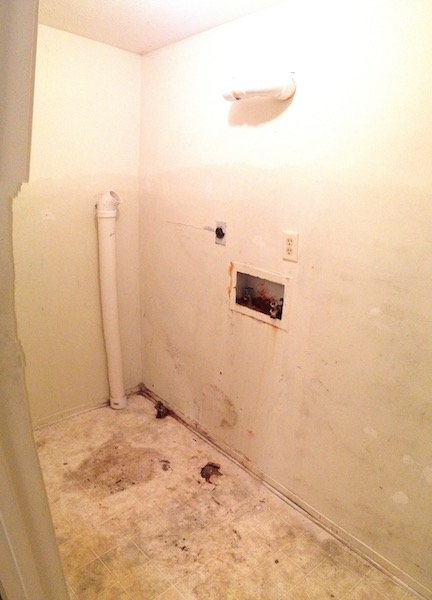How to Patch Drywall Holes – Explained By a Non Professional
If you own a house chances are good that at some point you’ll be looking at a hole in the drywall where there shouldn’t be a hole. If you own an apartment building, you’ll be looking at lots of holes in the drywall. Thankfully with a few simple tools and a little confidence those holes are easy to patch up.
The Tools
There are probably 3 ‘specialty’ tools that you absolutely need to do drywall work.
- A drywall jab saw. It looks like a big steak knife and makes short work of cutting drywall.
- A 5-6″ mudding knife (see picture below). It doesn’t really look like a knife, but that’s what it is called. It’s main job is to spread drywall mud around.
- A mud pan. Usually these are stainless steel and come in a small size (what I have below) and bigger professional sizes.
Raw materials that you’ll likely need would be drywall screws, a dry mix joint compound. Get something like Easy Sand 45. The number is an approximate amount of work time that you have before it stiffens up and you have a mud pan full of rock. The pros will use 5-20 minute, but I like to use 45. You may also want to pick up a 5 gallon tub of premixed compound. Get something with a blue top. Those are easier to sand.
While it might be tempting to skip the dry powder stuff, hot mud, and just use the premixed, try not to. The premixed mud is much weaker and will be more likely to crack if hot mud isn’t used first. Premixed is the frosting, it’s just there to make it look pretty.
Finally you’ll need some drywall scrap sheets. Every big box home improvement store that I have visited has had 2’x2′ or 2’x4′ panels of scrap drywall for $1-3 a piece.
Here are a few different holes and associated techniques that you may encounter or find useful.
The Emperor’s New Clothes
Do you see the holes?
What about now?
Yes. Somebody decided that it would be easier and or look better to cover up these two gaping holes with ductwork vents. Spoiler alert, there are no ducts in either of those cavities.
The correct fix probably costs less money. For the big hole, add in some scrap wood to act as a backing.
Then cut your replacement to size using a utility knife to score and snap and/or use the drywall saw.
Then add screws straight into the backing material. It’s important not to do the screws at an angle, and also not to break past the paper facing of the drywall. With the screws in, use a fiber tape to bridge the gap between old and new material. Try not to overlap the tape on top of itself.
For the ceiling patch, I chose to do the blocking a bit differently. I cut two pieces of scrap wood that were longer than the hole.
Then screwed through the existing drywall to hold them in place.
Then the patch gets screwed and taped in place.
Now you’ll need to mix up your hot mud (dry powder) in your mud pan. Add water to the pan first! If you do powder then water it is going to be a PITA. You only need a quarter inch of water. Now add powder and mix until you get the consistency of soft serve ice cream. It is important to have it well mixed and no ‘boogers’ in there. Boogers, or technically clumps of dry powder, will smear across the work surface and make it really ugly.
Use the mud pan and the taping knife to spread the mixture across your patches. The goal is to completely cover your tape so it isn’t poking through, while trying to avoid any huge humps, bumps, or ridges. Experiment using different amounts of pressure and try feathering out the edges. Don’t overthink it, this is just something that takes practice. Your first patch won’t be a work of art.
This first rough coat will take a few hours to set up and harden. Go watch some tv or take a nap while you wait.
We’re almost done. Yay! Now that the first rough coat has hardened, knock down any high ridges with your taping knife. Ideally, you’ll go up a size or two in knives with each successive coat. With the mud coat on, it’s time to break out the pre-mixed icing. Slather it on just like the first round.
For the ceiling texture, I found that an old paint roller gave a pretty good result.

GOOAALL!!
The soccer hole is when you get really excited and kick a hole through the drywall.
Another common variation is the doorknob punch where you throw open the door and the knob punches through the drywall. For these types of holes, I like to use a ‘California Patch’. What is nice about the California patch is that it requires zero screws or tape. Use a drywall saw to square up the hole. Yes, make the hole bigger. Once you have a rectangular hole, use a utility knife to score a piece of replacement drywall that is 2 inches wider and longer than your hole. You may also need to use the drywall saw to cut your replacement piece. Now, carefully score the back side of the replacement piece with 1″ margins. Then carefully peel away the margins.
With your patch with paper margins ready, smear up the backside of the margins with mud and place it into the hole. Use your drywall knife like a squeegee and squeeze out all the excess mud from behind the paper. Then use a bigger knife to apply a finish coat of ready mix mud to cover up the patch. Wait for it to dry (24-48 hours) then sand smooth.
The Mouse Hole
I’m not really sure what caused this. Perhaps it was a pet, a child, or critter, but regardless it patches up just like GOOAALL.
Enlarge the hole using a drywall saw to make it rectangular. Then create a California patch for that hole. The scratches in the wall will fill in with mud nicely.
The Leaky Plumbing
Sometimes you have to make the hole in the wall to fix something else.
Patching drywall isn’t too difficult and it is quite cheap to boot. Of course, the best way to make drywall look nice is to not knock holes in it in the first place. Prevention, prevention, prevention!
